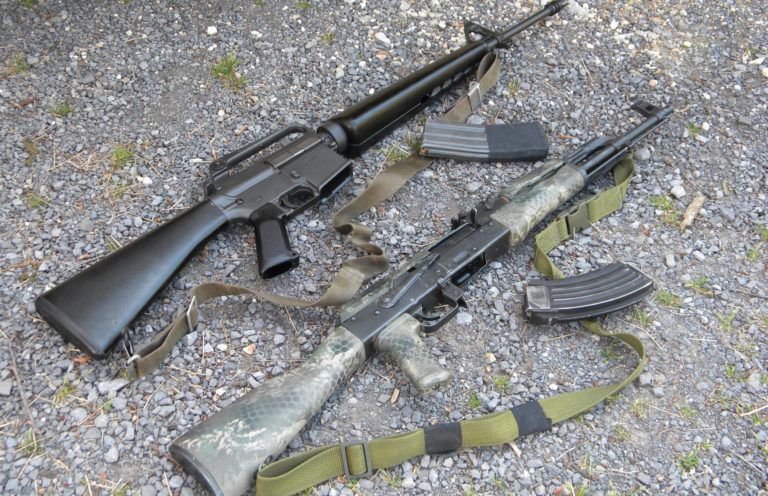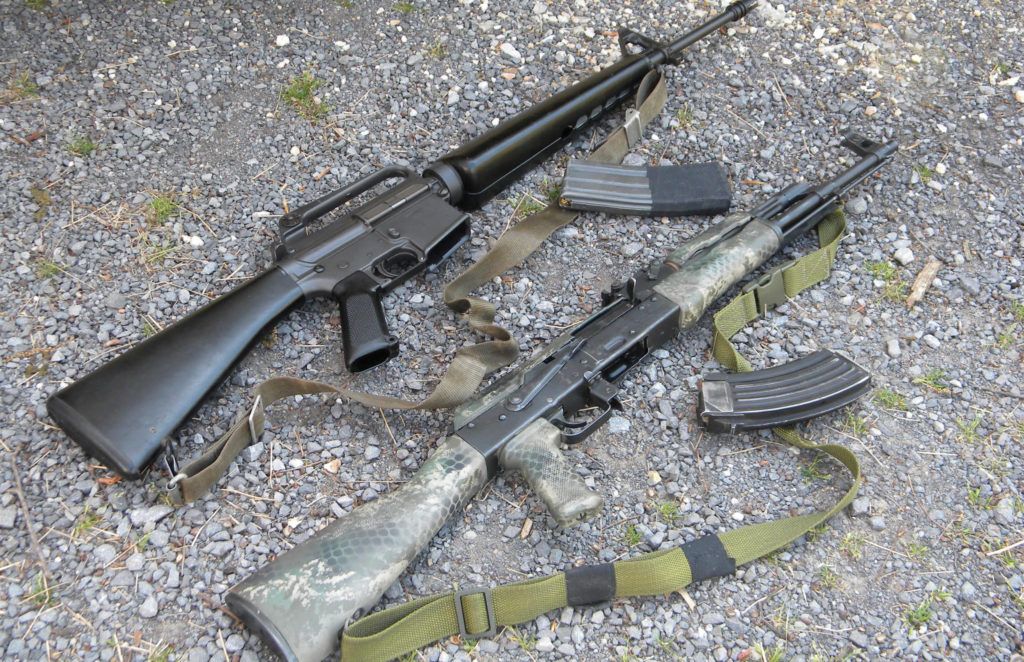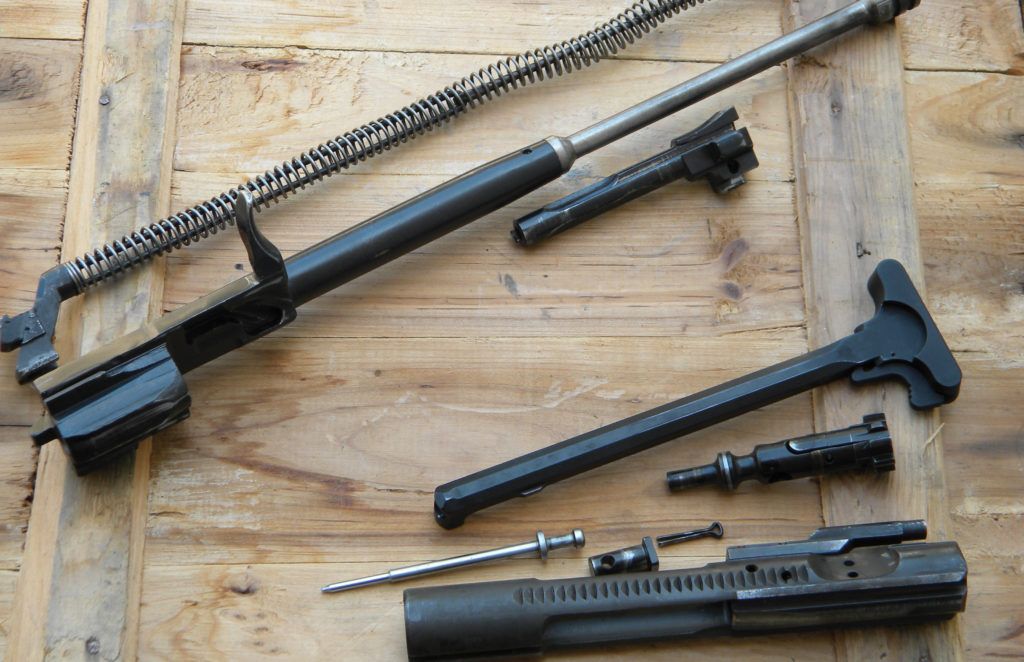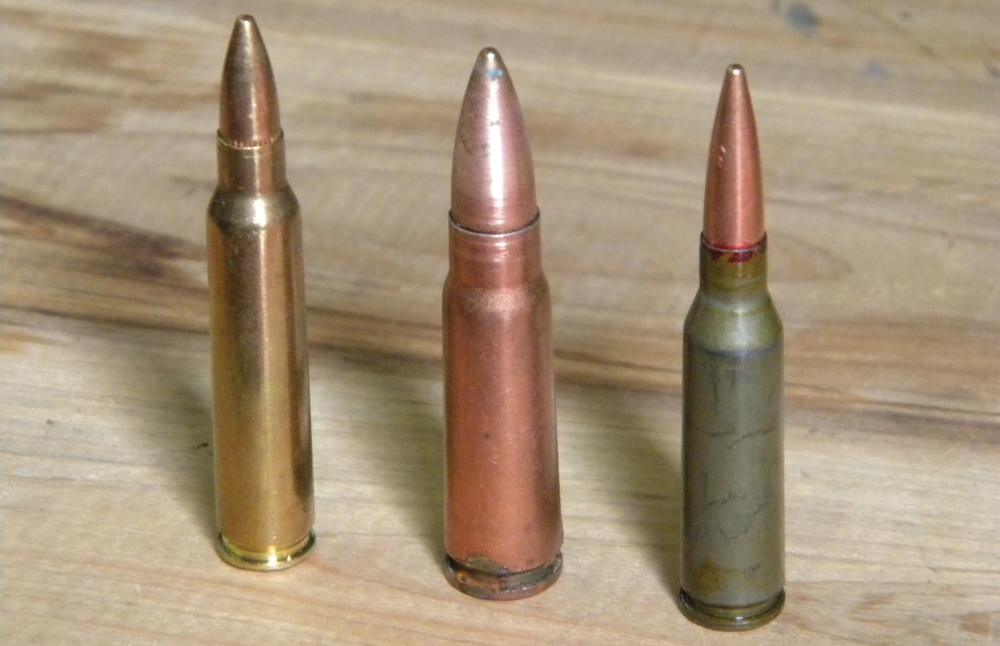
Like day and night, the AR-15 and AK-47 were designed for different purposes. Which one is right for you?
The major differences between AR-15 and AK-47:
- AK-47s shoots 7.62x39mm.
- AR-15s were originally chambered 5.56x45mm.
- AKs have a maximum effective range of about 300 yards.
- ARs have a maximum effective range of about 800 yards and beyond.
- The Russian gun operates with a long-stroke piston.
- The American rifle utilizes a variation of the gas impingement system.
- ARs are more modular than AKs.
Debating on whether the AR or the AK is “better” is like arguing whether a Ford Mustang is superior to a John Deere tractor. Both have four wheels, engines and transmissions, but they were designed for completely different applications. The AR and AK do exactly what they were designed to do, and they both do it well.

WWII was the catalyst for both weapons. There was no more trench warfare — the Germans had launched the “Blitzkrieg,” or “lightning war.” This principle relied on tanks, artillery and aircraft, and plenty of ground troops to smash through the enemy, overwhelming their defenses. During the first half of WWII, the Germans were almost unstoppable. Post war, the winners began studying, testing and designing weapons and tactics based on this new paradigm.
The time of the “intermediate” cartridge had arrived. During the war, battle rifles ruled the field. These rifles fired full-size cartridges — the 7.62x54R Mosin Nagant or the American .30-06 M1 — with an effective range of 800 yards or so. Studies from WWII showed fights occurred at much shorter distances, and more rounds fired increased the chances of winning. Full-auto fire used by Germans during the war was the path to victory. The intermediate cartridge, the German Sturmgewher, was smaller and fired from a shorter, lightweight platform and was controllable during full-auto fire. The smaller round also allowed soldiers to carry the ammunition necessary to sustain a high rate of fire.
What’s interesting is that the Soviets, known for their heavy-handed bureaucracy, moved quickly through development and fielding of the AK-47. Design began in 1945, and the AK-47 was issued to troops in 1949. The United States, known for its innovation, took a longer route. Due to political pressure, financing or stubbornness, the United States adopted the .308 caliber M14 in the mid 1950s. The M14 is still a heavy battle rifle, and the .308’s recoil was too much to control on full auto. It didn’t perform well against the automatic fire of the AK in Vietnam, and it was replaced by the fully automatic AR-15, known now as the M16, in the mid ‘60s.
Design Differences
The AK-47, which was attributed to Kalashnikov but designed by a team, is a simple, rugged and reliable large submachine gun. Although it’s simple, don’t let that fool you: As Soviet weapon designer Georgy Shapgin said, “Complexity is easy. Simplicity is difficult.” In fact, Kalashnikov’s original designs were too complex, and the team made hundreds of modifications before the final design.

The AK is easy to manufacture and cheap to produce. The original design used stamped and welded receivers, with furniture made from birch wood laminate, which is cheap and durable. It was built with loose tolerances, making the AK a “self-cleaning” carbine because its fired dirt and debris were blown out of the AK.
The AR/M16 is almost a direct contrast to the AK. Although Stoner borrowed from others, just as Kalashnikov, the ultimate product was unique. It’s more complex in design and manufacture. The AR-15/M16, originally only offered as a rifle, utilized aluminum, plastic and a unique gas impingement system that made recoil extremely controllable. In design and application, the AR-15/M16 is for professional soldiers.
Due to the AR’s modular design — it’s easy to swap out parts — the civilian market contributed heavily to the development of aftermarket parts. This included free-floating handguards, a variety of barrel/caliber options and improved trigger assemblies, just to name a few. The introduction of the flat-top upper receiver in the early ‘90s was a major factor. Instead of a carry handle, the upper has Picatinny rail on top to attach various sights. The military incorporated many of these features into specialized rifles and carbines.
It took longer for accessories for the AK to come to market. One factor was the lack of availability. AKs didn’t really become popular and available in the United States until the 1990s. Plus, the AK is not as modular as the AR. Today, there are plenty of aftermarket parts for the AK, and radical customizations are available. It’s almost at the point where it’s sometimes difficult to rapidly distinguish between an accessorized AR and an AK.
Function Differences
The AK’s simplicity makes it easy to “learn.” A large number of Soviet troops were uneducated, couldn’t read or write and spoke various languages. You don’t need a technical manual to learn how to operate and maintain the AK: It field strips down into six main parts, which makes it easy to maintain. Critical components with tight tolerances are not made to be disassembled unless absolutely necessary. In fact, it’s so simple it became the standard weapon for child soldiers, small boys forced into combat during the African civil wars of the late 20th and early 21st centuries.

The AR is more complicated than the AK, but its ergonomics are much better. For example, it has a charging handle and a bolt catch. When the bolt is locked to the rear, such as during an empty reload, you use the bolt catch as a release as opposed to cycling the charging handle. This is much more efficient than cycling the charging handle — with the AK the charging handle is used for everything. Once you know the right techniques, it’s easy for a right- or left-handed shooter to operate the AR efficiently.
Reliability Differences
Nobody questions the AK’s reliability. It has functioned well in every kind of environment and under all conditions. The gas piston design is perfect: You can bury an AK in the dirt, come back a year later, crack the bolt open with your foot on the charging handle, dump some motor oil in it and bang away. AKs work.
Initially, the AR experienced some growing pains due to specs changed in the design and the components used in the ammunition. Since then, it’s definitely earned the title of “America’s Rifle,” and it’s the longest serving standard-issue rifle of America’s armed forces. Most people think the AR’s gas impingement functions too dirty for reliability. They will run dirty — we have one with more than 20,000 rounds through it without a cleaning. The key, however, is lubrication. Keep your AR “wet” and it will run reliably. At some point you may need to replace an extractor or ejector spring or the gas rings on the bolt, but this is an easy task.
Accuracy Differences
The AK-47 fires a 7.69×39 round (the AK-74, an updated version of the classic, fires the 5.45×39 caliber). Due to its loose tolerances, the AK isn’t known for surgical accuracy. It will group 6 inches or so at 100 yards, with a maximum effective range of about 300 yards. For the AK’s design and purpose, this was deemed good enough. Today, there are accurized versions of the AK, but to me this goes against the grain of its design.
The AR is built to tighter tolerances than the AK, making it extremely accurate. The first Colt H-Bar I bought in the 1980s shoots 1-inch groups at 100 yards exactly as it came from the factory. With the proper barrel/twist rate and the right ammo, the AR is capable of getting accurate hits out to 800 yards and beyond.
Which One?
So, which one is best for you? I recommend at least one of each! Both the AK and the AR are reliable, easy to shoot and fun, and they perform exactly as designed. I prefer to stick with the original concepts — my ARs are gas impingement and fire .223 Rem./5.56 NATO. My AKs are 7.62×39 with no modifications.
But, if you so desire, you can have an AR with the AK’s gas piston design, one that fires 7.62×39 ammo or an AK that shoots .223/5.56 ammo. Regardless of which direction you go, remember that it’s up to you to learn how to use it safely and efficiently, and to have the knowledge and parts to maintain it, ensuring reliable service for years to come.
Our Top Articles on AR-15 Builds and Performance
- Best AR-15 Options For Any Budget
- Comparing AR-10 and AR-15 – How Stoner’s Rifles Stack Up
- Best AR-15 Upgrades – The Best Parts & Accessories
- Assembling an AR-15 Lower – Putting The Internals Together
- How it Works: AR-15 Upper Parts & Assembly
- Buyer's Guide: AR Pistol Braces
- Affordable AR Pistols – A Buyer's Guide
- Choosing AR-15 Calibers – What Should You Chamber Your Carbine?
Editor's Note: This article originally appeared in the June 2018 issue of Gun Digest the Magazine.

Next Step: Get your FREE Printable Target Pack
Enhance your shooting precision with our 62 MOA Targets, perfect for rifles and handguns. Crafted in collaboration with Storm Tactical for accuracy and versatility.
Subscribe to the Gun Digest email newsletter and get your downloadable target pack sent straight to your inbox. Stay updated with the latest firearms info in the industry.

![Best Concealed Carry Guns In 2025 [Field Tested] Wilson Combat EDC X9S 1](https://gundigest.com/wp-content/uploads/Wilson-Combat-EDC-X9S-1-324x160.jpg)


![Best 9mm Carbine: Affordable PCCs [Tested] Ruger Carbine Shooting](https://gundigest.com/wp-content/uploads/Ruger-Carbine-Shooting-100x70.jpg)


My AR with a thermal scope is the perfect hog rifle. Accuracy is far more important than impact.
I took your advise, I have one AK that I just bought and four AR’s that I built myself. It’ll take me a while to warm up to the AK
While there’s plenty of good, easy to digest, basic information in this article, it also seems to parrot many of the ancient myths, especially in the case of the AK-rifles.
Like that “maximum effective range” thing. I’ve seen people fire 7.62×39 well beyond 500 meters, with Finnish Defense Forces even using 7.62 RK-rifles + AGOC scopes as their “DMR”, engaging targets up to ~425 meters. Obviously they don’t use beaten up Russian guns or cheapest Commie-block surplus ammo, but match-grade SAKO cartridges.
Even then, with mere irons, you can do some around 2×2 inch groups with a regular AKM’s irons at 100 yards, with any kind of optic + stable stance improving the precision further.
Besides those nitpicks, there are also various pros to the 7.62×39 Kalashnikovs and the ammo itself. For starters, it performs well out of various barrel-lengths, acing even through PDW-sized weapons. The 5.56 / .223 ‘s performance and stability suffers a great deal the shorter the barrel gets, and you really need to pay attention to the twist-rates to get the best results.
The 7.62 can also be suppressed surprisingly easily, where as the faster 5.56 requires specialized ammo
Finally, my favorite AK “feature”:
Ran out of ammo? Just use the rifle as a steel club!
The AK is also heavy.
I have three 7.62×39 AR uppers which I’ve run on a whole lot of lowers, and the only issue I’ve had was “hard primers”, and Velocity Triggers solved that. ComBlock steel case typically is 2.5 moa; handloads 1.25 moa with bulk bullets. The Comblock ammo is “dirty” – I have to clean the x39 upper after about 600 rounds. :=)
I’m not saying that the AK isn’t fun, not sayings it’s not almost perfect for it’s designed purpose. I just prefer the lighter weight and better accuracy of the AR.
A fan of both rifles, I admire fine engineering and am compelled to tinker with off the shelf gear, hopefully to refine its operation and function. I own three ARs, a 16″ & two which I’ve assembled myself, an 18″ & 20″ chambered NATO or Wylde & several AKs. ARs a perfect for coyotes, AKs for hogs.